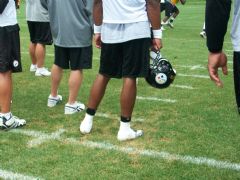The ever-dynamic editor of the British Journal of Sports Medicine, Karim Khan pertinently tweeted a link to the systematic review of the literature concerning CTE & the evidence supporting its description as a distinct syndrome, which was conducted by Gardner et al (2013) & published by the journal earlier this year. The authors considered the range of clinical presentations, neuropathology & strength of evidence illustrated in 158 published case studies.
The main issue highlighted the critical differences in the older descriptions of CTE (the "classic" syndrome) & the more recent descriptions (the "modern" syndrome). The age of onset, natural history, clinical features, pathological findings & diagnostic criteria were all aspects of disparity that suggest the "modern" syndrome is a different entity. As a result the authors concluded that further research was required to clearly define the clinical phenotype of the modern CTE syndrome & establish the underlying aetiology.
Following on from this study, the same group went on to review the evidence for the occurrence of CTE in retired athletes & consider the potential differential diagnoses that require consideration when such individuals present with cognitive & psychiatric problems (McCrory et al, 2013). The available research was considered limited at best, relying on single case studies & as such the authors concluded that it is not possible on the evidence currently available to determine the causality between repeated concussions, sub-concussive impacts & CTE.
Meanwhile, the tabloid press jumped on the story to highlight the concerns in the sports medicine fraternity regarding the controversial Pitchside Suspected Concussion Assessment (PCSA), which saw Dr. Barry O'Driscoll resign as the IRB's Chief Medical Officer upon its introduction. Dr. O'Driscoll is appalled at the protocol's demand for the assessment to be completed within 5 minutes of the player leaving the field. The Daily Mail quotes him as saying that "There's absolutely no justification for the five-minute rule. It's a completely unjustified experiment, & it is playing Russian roulette with rugby players' health".
This "unjustified experiment" clearly failed in the last of the British Lions' test matches against Australia, when after being involved in a colossal clash of heads, Australia flanker George Smith, was thrust back into the action after undergoing the 5 minute test...despite being obviously concussed! This has lead to calls that the IRB is trivialising the issue of concussion.
On a less controversial note, BrainLine.org posted a video interview with Dr. Robert Cantu MD, the Clinical Professor of the Department of Neurosurgery & co-Director of the Center for the Study of Traumatic Encephalopathy , Boston University School of Medicine.
Dr. Cantu is the senior advisor to the NFL Head, Neck & Spine Group & presented information on how to help former athletes with the prolonged symptoms that can often present with "post-concussive syndrome".
The upshot of the NFL case - more & more pressure is being put on those that underplay the importance of concussive incidences, to be more respectful of the injuries, management of the assessment procedures & subsequent return to play pathways. Not a bad thing.
It is with this in mind, that I am organising the Sporting Concussion Management Symposium that will take place in Hong Kong on 1st & 2nd February, 2014 as the first instalment of the Asian Emergency Sports Medicine Conference. I can assure you too that the list of speakers that have agreed to get involved is already looking quite impressive!! More to come in the coming days & weeks but if this is a topic of interest, keep the dates free.

